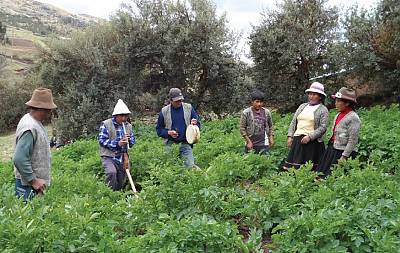- Peru


Traditional Agriculture of the Chinchaypucyo District of Peru

© Claudia Palomino Valdivia y Roberto Ojeda Escalante
1. ICH domains
Oral traditions and expressions, social practices, rituals, festive events, knowledge and practices concerning nature and the universe
2. Short description
In the district of Chinchaypucyo, located in the region of Cusco, Peru, agriculture is developed through rituals and ceremonies dedicated to plants, animals and the geographical elements that shelter them (e.g. land, lakes and mountains). To this regard, a project entitled, “Creating ourselves between plants and people: recovery and transmission of agricultural and medicinal knowledge as part of the intangible cultural heritage of the Chinchaypucyo District” was developed. The project was based on the memory and traditional practices of the elders of different communities in the district, and aimed to identify, document, investigate, and promote their ancestral agricultural, medicinal and gastronomic knowledge. It contributed to raising awareness of the importance of these agricultural producers and food security, and was funded by the Regional Center for the Safeguarding of the Intangible Cultural Heritage of Latin America - CRESPIAL.
Further information:
The following links, to a video and a book (both in Spanish), describe the intangible cultural heritage element in greater detail:
https://www.youtube.com/watch?v=lwt-CZc1IMc
http://www.crespial.org/public_files/1496771903.pdf
3. Link with sustainable development
The holistic vision of the project reflects an Andean perspective: equity between humans and natural elements. The project helped to improve nutrition and end hunger, strengthening local organizational capacities and technical abilities in agricultural production, as well as enhancing relevant knowledge. More broadly, the traditional agriculture of Chinchaypucyo reflects the aims of SDG 2, dedicated to ending hunger, achieving food security and improved nutrition and promoting sustainable agriculture, as well as SDG 12 encouraging responsible consumption and production, thereby ensuring sustainable consumption and production patterns.
4. Questions for reflection
Do you know of examples where a project was aimed at the recovery and/or revival of agricultural practices?
What were the challenges encountered and what was done to overcome them? Did the community give heritage value to it?
Do you know of examples where a project involved community participation similar to the above project? What are some of the benefits and challenges of doing so?